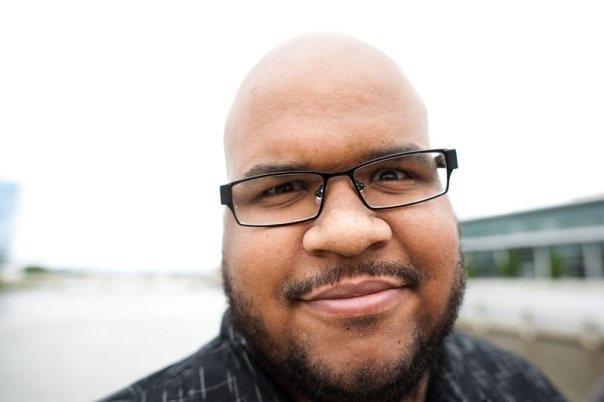Duke Greene gives a writer's view of the visual arts
Duke Greene, Grand Rapids poet, gives his opinion of this year's ArtPrize entries and talks about his clarifying requirements between "good art" and "great art."

Duke Greene performances can be found at:
Duke Greene performs often at the Eastown Hookah Lounge's “Smokin' Spoken Word” every Wednesday night. Also, his rap group, Noblesville will open for Kool Keith at the Pyramid Scheme on October 31st.
Duke Greene, Grand Rapids local poet and hip-hop writer, has no formal artistic training. He does say that some of his teachers at Northview High School were the first to push him for excellence. He wrote his first song in 8th grade, but decided to take his art seriously in his “sophomore or junior year of high school.” Greene doesn't believe that any academic study is necessary to be a successful artist. “I just study the success of others,” he says. “I find people who have what I want, and I study what makes them successful.” When he is writing, Greene says he is happier than when he does anything else: “My mind is like a white-hot laser.” In spite of this, there are more important things in his life than his art. When asked if he would label himself as an artist before all else, he replied that he sees himself as a father first. His young daughter is the most important thing in his life, and Greene sees even his artwork through the lens of being a father. “To me, writing is kind of like playing the lottery. Maybe someday I'll be able to support my family through it, but it's not guaranteed.”
Greene had spent a great deal of time recently exploring the different ArtPrize exhibits. He related to me one of his favorite exhibits of the year; a piece called “What Problem?” by Elizabeth Eberhard, on display at The B.O.B near Fulton and Monroe. This piece, relatively simple at first glance, is a collection of patio furniture arranged around signs saying “For White People” and “For Black People.” The exhibit invites the viewers to rearrange the furniture in any way they see fit, in effect making the viewer a participant in the installation.
And participate he did. Duke sat at a chair near the “Black People” sign, while his Caucasian wife sat near the “White People” sign, and the two held their mixed race daughter in between.
Greene says he enjoys the opportunity to see the new and exciting art that ArtPrize brings to the city, but claims the contest is not without its flaws. Duke criticizes the contest for tacit prejudice in its voting process. Many of the ArtPrize exhibits attempt to expose the hardships and injustice that burdens low income and homeless people, yet he explains that these people may be unable to vote in the contest due to lack of access to technology (nearly all ArtPrize voting is done either online or with a cell phone) or lack of official identification (Registering to vote in ArtPrize requires a government-issued ID.) In addition, he says that an artist may have a very specific audience in mind when he creates a piece, and that letting everybody vote on that may be inappropriate. “It's turning into American Idol.” he says.
This begs the question, “What constitutes great art?” Greene says that the art entered in ArtPrize is either good or great, but that the two are very different things. Good art, he says, is usually aesthetically pleasing, relatable, and technically difficult. Last years winner, 'Cavalry, American Officers, 1921' exemplified this, “Especially the 'technically difficult' part,” he says with a laugh, recalling the giant, photo-realistic pencil drawing. However, he would not say that this piece would count as 'great art.'
“The three words I'd use to describe great art are: personal, emotional, and challenging, in an intellectual sense.” Greene says. He relates that he's seen many pieces in this years competition that qualifty as “Great Art,” but that they will probably lose to more viscerally impressive “Good Art.”
In spite of all this, Greene says that ArtPrize is a good thing for the city, allowing local artists the opportunity to be seen, and allowing those with little experience in art to go out and see it firsthand. Anything that increases public awareness of the arts is a win in Greene's book.

A core service of the Grand Rapids Community Media Center


